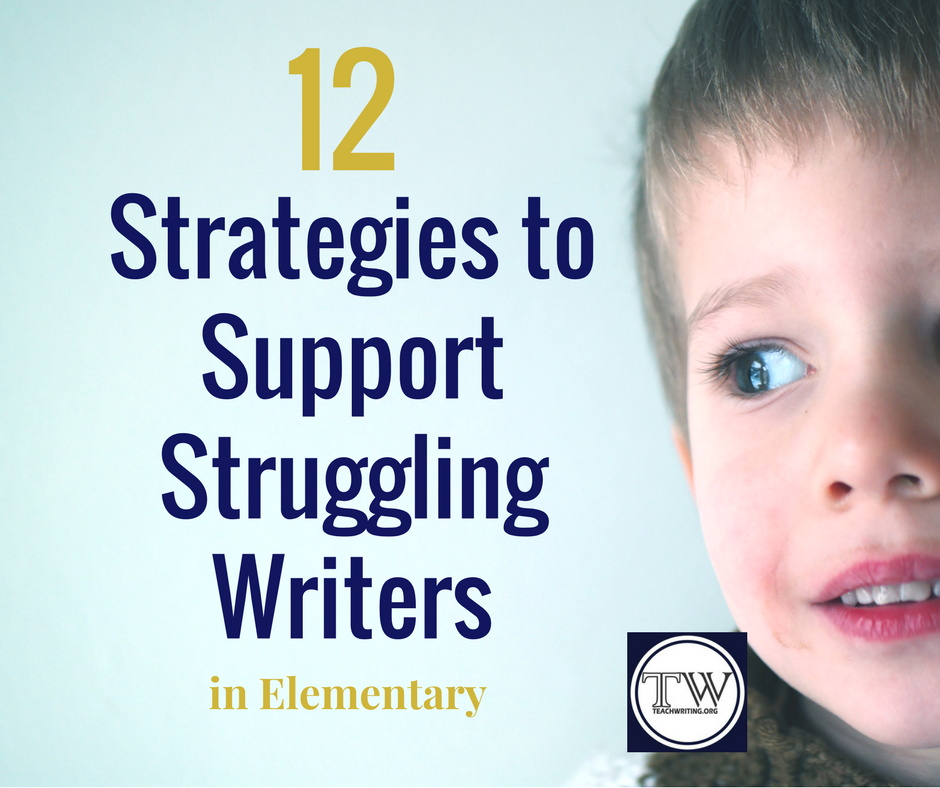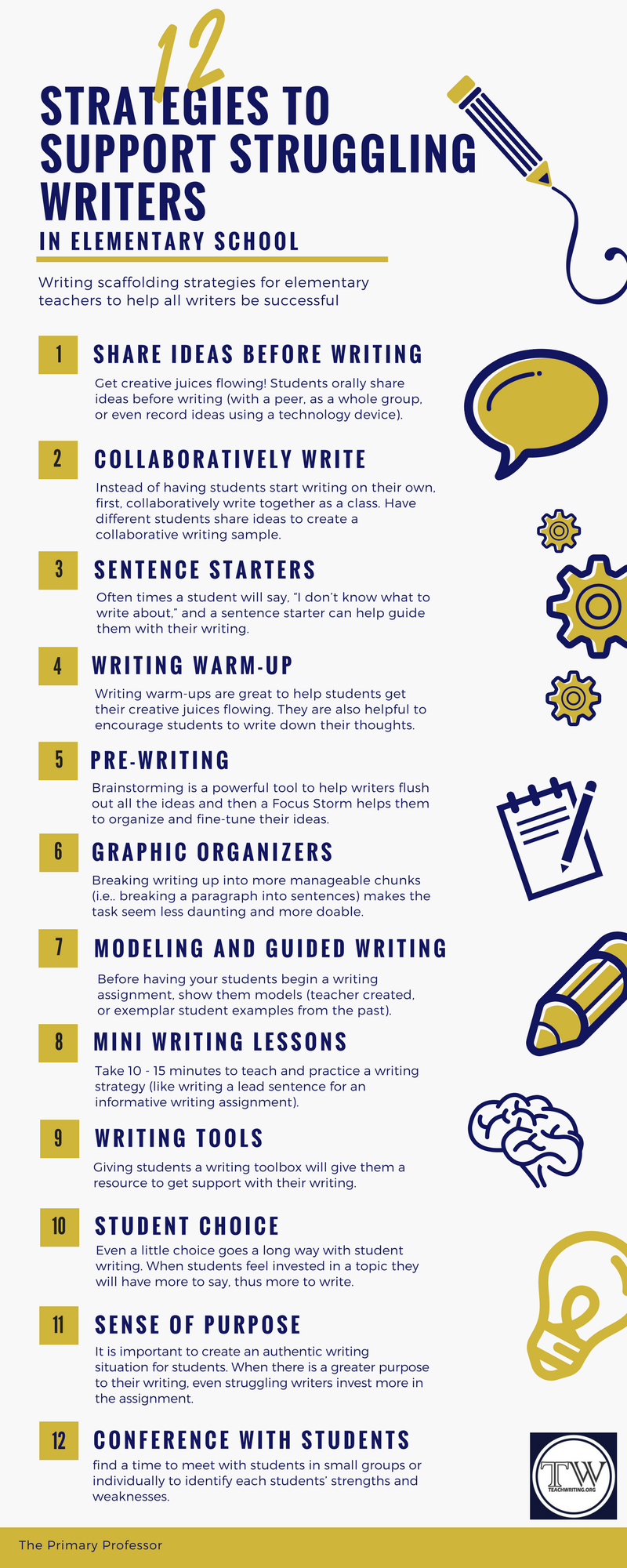12 Strategies to Support Struggling Writers in Elementary
Have you seen this before? A student is up from his desk (again!) going to get a drink for the third time during the writing block. Another student is sitting quietly at her desk starting a blank piece of paper (trying to fly under the radar). And then you have a student claiming to be finished with the writing assignment, yet it is clearly incomplete and disorganized. Sound familiar? Well, all these signs point to struggling writers.
Types of Struggling Writers
Just like our students, not all struggling writers are the same. Some students struggle with writing because they are stuck for ideas. You know the kid…the one who proclaims, “I don’t know what to write,” then shrugs and stares blankly at you. Those are also often the students getting up to get another drink of water and staring at a blank page. These students struggle with getting started and knowing what to write about.
Other students struggle because their writing is disorganized and lacks structure. These students will often write, but their writing is disorganized and hard to follow. They often claim to be finished with a writing assignment before it is truely complete.
Finally, another group of students struggle with writing because they feel disconnected from the assignment. They may feel it is not relevant to them or they may not have the background knowledge or expertise to write on the topic.
With a little scaffolding and support, there are many strategies you can implement into your writing instruction to help support your struggling writers.
Stuck for Ideas
When students struggle with coming up with ideas about what to write about, try the following scaffolding tips:
1. Share Ideas before writing
Students orally share ideas before writing (with a peer, as a whole group, or even record ideas using a technology device) - This gets their creative juices flowing. Students who struggle with coming up with their own ideas might get inspired by their classmates’ thoughts. Having students share ideas also helps to solidify and ground the idea so it isn’t lost.
2. Collaboratively write
This is an opportunity for the whole class to get involved. Instead of having students start writing on their own, first, collaboratively write together as a class. Have different students share ideas to create a collaborative writing sample. This demonstrates for struggling writers how to approach the assignment and it provides them with ideas of what to write about.
3. Use sentence starters
These are really helpful for triggering ideas in struggling writers. Often times a student will say, “I don’t know what to write about,” and a sentence starter can help guide them with their writing.
4. Writing Warm-up
Writing warm-ups are great to help students get their creative juices flowing. They are also helpful to encourage students to write down their thoughts. Using a writing warm-up like Power Writing or Freewriting: (where students write without stopping or without worrying about spelling or grammar) their ideas can flow and they don’t have to deal with writing paralysis.
5. Pre-writing
This is a critical step for helping struggling writers construct ideas. Using tools like brainstorms or Focus Storms, help students quickly get as many ideas as possible. The blank page can be daunting to a young writer who struggles with coming up with ideas. Brainstorming is a powerful tool to help writers flush out all the ideas and then a Focus Storm helps them to organize and fine-tune their ideas. This is also helpful because it is a visual for students to see that they have lots of ideas. If students ever get stuck for ideas, they can refer back to their brainstorm and focus storm.
Disorganization and Lack of Structure
This was one of my biggest struggles as a young writer. I had lots of ideas, but I rarely put them together in a coherent fashion. Instead, my writing was a disorganized, jumbled mess. Many young writers struggle with this aspect of writing, and these scaffolding tips are a best practice when teaching young students. Whether it is a paragraph or an essay, these strategies help support struggling writers in elementary school.
6. Chunk assignments with Graphic Organizers
Many struggling writers do better with a visual. Breaking writing up into more manageable chunks (i.e.. breaking a paragraph into sentences) makes the task seem less daunting and more doable.
7. Teacher lead modeling and guided writing
Before having your students begin a writing assignment, show them models (either teacher created, or exemplar student examples from the past). Additionally, if you are having a student write a hook, model to the class, how you would write a hook. By thinking aloud, this demonstrates for the struggling writers how they can approach the same situation. This is a good time to encourage students to share their samples. Additionally, this helps spark ideas in students who might be stuck.
8. Mini Writing Lessons
Don’t expect students to know how to write an engaging lead sentence, or use transitional phrases fluently. These are excellent mini-lessons to incorporate into your writing block. Take 10 - 15 minutes to teach and practice a writing strategy (like writing a lead sentence for an informative writing assignment). Once you teach the skill, have students immediately practice it in their writing. As you introduce more mini-writing lessons, don’t forget to still touch on ones you have covered in the past.
9. Provide students with writing tools
Giving students a writing toolbox will give them a resource to get support with their writing. For instance, provide students with a list of transitional words and phrases for the writing they are tackling. Or give students a list of Dead Words that they should avoid using in their writing and a list of alternative words to use instead. Giving students a resource to refer to while writing will help them overcome their writing challenges.
Disconnect from Assignment
Sometimes the problem with struggling writers is that they just don’t care about the assignment given. Either they can’t connect to the assignment (they don’t have any experience going to the beach, so how can we expect them to write a story about going to the beach), or there is no motivation with the writing purpose - another paragraph for the teacher, who cares! These two scaffolding tools can help to increase motivation and create an authentic writing experience.
10. Student choice
Give students choice with what they write about. Even a little choice goes a long way with student writing. When students feel invested in a topic they will have more to say, thus more to write.
11. Sense of Purpose
Except for those teacher-pleasers and highly intrinsically motivated students, there is little drive and motivation to do their best work when students are simply writing for a teacher to grade. Thus it is important to create an authentic writing situation for students. Have them write a blog post to share with the entire third grade, or have them create a persuasive travel brochure. When there is a greater purpose to their writing, even struggling writers invest more in the assignment.
Sometimes students struggle in more than one area or they need more individualized support.
12. Conference with students individually and in small groups
Since students are so different with their writing abilities and their struggles, it is important to find a time to meet with students in small groups or individually to identify each students’ strengths and weaknesses. Knowing which areas to target for each writer will allow you to scaffold and support each student in the area in which they could benefit the most.
My goal as a writing teacher is to help all my students feel successful with writing. I scaffold writing instruction to support all my struggling writers from the kids who struggle with coming up with ideas, to the writers who need support.
I would love to hear about any strategies you use to support struggling writers in your classroom!
Happy Writing,
Whitney
MY STORY
I’m Whitney Ebert, founder of ElementaryWritingCoach.com. As you may have guessed, teaching young authors to develop their craft and feel confident in their writing skills is kind of my thing.
I have 10+ years teaching experience in elementary education, and I've taught every grade level from kindergarten to sixth grade (except first). My teaching passions include interest-based learning, creative technology, project based learning, and building confident writers. Additionally, I have my M.S. in Instructional Media, so I frequently incorporate digital flare into projects and writing assignments.
I live in a sunny beach town with my husband and toddler (and a new little one on the way). When I'm not teaching, blogging, or designing new lesson plans, you can find me at the beach with the family.
Find out more about The Primary Professor at: www.theprimaryprofessor.com



